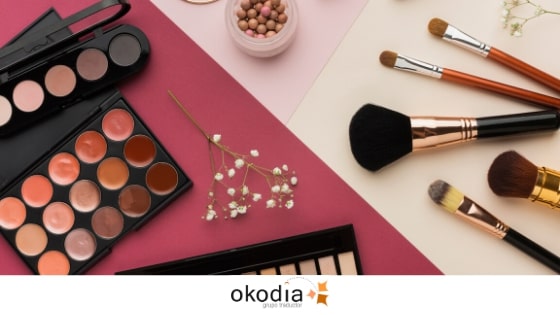“Sombra aquí, sombra allá, maquíllate, maquíllate”. These are the lyrics to a Spanish song by the iconic group Mecano, which can be roughly translated as “Shadow here, shadow there, makeup, makeup”. The lyrics are quite right, as current beauty wisdom means that makeup and cosmetics are used more and more often to care for the skin. That is how we do our make up at Okodia and in the world, with rigour! But are beauty tips translated too? Cosmetics translation is almost as important as the active ingredients in the cosmetics. Keep reading and you may be surprised!
The colour palate of cosmetics translation
Cosmetic companies want to sell, sell, sell; but to achieve good results they cannot simply make the product available for sale. They first have to add a bit of colour at least. The starting point when translating beauty is the strategy of the cosmetics industry. Many companies begin their evolution with a strong commitment to product innovation and marketing, two areas where having accurate translations is key to ensuring regulatory compliance. Also essential is accurately conveying their value proposition in the local language of consumers all around the world.
However, so that consumers really understand the beauty products they are going to use, it is important to start with the advertising message and ensure that this message, the result of a clear marketing strategy, reaches different countries and adapts to their local cultures.
Adapting the advertising power of the language of cosmetics into the different languages is only possible when the translation is carried out in the highly professional way that only a professional translation agency can guarantee.
Another aspect that we shouldn’t forget to mention in cosmetics translation is handling product packaging. We’re talking about products that, after all, sell beauty, as well as physical and emotional well-being. So, we already know first-hand that cosmetic product containers are planned down to the last detail: ergonomic packaging, sophisticated designs and fonts that reflect the brand’s corporate identity. At this point, it’s worth mentioning that in cosmetics translation, we maintain the distribution of graphic elements as much as possible. To this end, we use computer systems that insert the translation into the original layout while keeping the design and visual composition of the product.
Adapting the advertising power of the language of cosmetics into the different languages is only possible when the translation is carried out in the highly professional way that only a professional translation agency can guarantee.
The composition
Let’s be honest, what sells in today’s world is marketing, but the composition of a product can end up being the deciding factor in people buying it. When carrying out a cosmetics translation, it becomes clear that the name on the packaging is not the only thing to be translated (and at times that name stays the same, depending on the country the product is being exported to) because the label also needs translating. The labels for these products normally give information about the product and the ingredients that comprise it.
This is where another complexity of cosmetics translation comes in. In fact, at Okodia Translation Services we make sure that we choose someone who is not only a professional translator fluent in the language, but also someone who is a specialist in the translation of scientific documents. In cosmetics translation it is vital not to miss out anything that appears on the label. The International Nomenclature of Cosmetic Ingredients must be specified. Consumers have the right to know what elements are used to produce a cosmetics product in case they are allergic to any of them.
When it comes to chemical elements, the fact that consumers might not fully understand them does not mean to say that the cosmetics laboratories should not worry about translating them correctly. In addition, they must also be sure to accompany the product with some marketing messages that explain to the consumer just how to use it and what its properties are.
How does that work?
Someone, somewhere, must translate the instructions for a facial mask into Japanese so that Japanese beauty lovers can use it properly. And what would Lisbon hairdressers do if the instructions of the new hair dye had not been translated into Portuguese? Would depilation devices still be painless if we didn’t have the specific instructions in our language? Once again, the world needs a good translation service.
As you can see, in cosmetics translation it is essential to be accurate, given that a poor translation of the components could lead to disaster. However, it is just as important to be creative, since there is an extensive marketing process behind each product. If you would like a real beauty of a cosmetics translation, click HERE.













